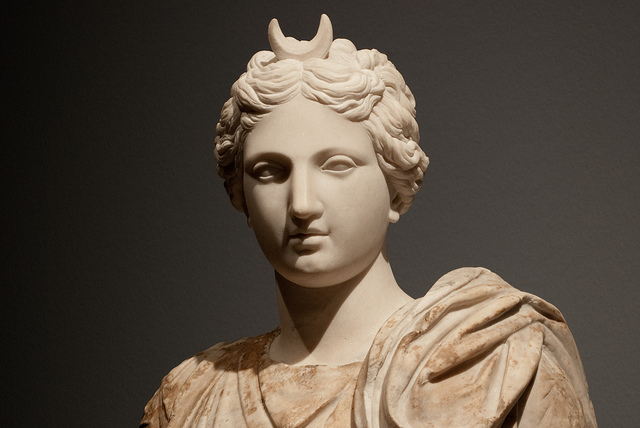Moon Goddess of Ancient Greece: Who is Selene?
Goddess Selene, with her silver wings and golden crown, was shining brightly in the lands of Ancient Greece. Selene, the moon goddess, became a symbol of the glorious night as a legendary light in the darkness; She had stolen the hearts of ancient poets, writers, and orators.

Selene, the daughter of the titans Hyperion and Theia, is the dominant and main moon goddess in early Ancient Greek mythology. Selene, also known by the nicknames Phoebe (not to be confused with her aunt Phoebe) and Mene, was thought of by the Ancient Greeks as the physical personification of the moon, not just a symbol or icon of it.
As with all celestial goddesses, Selene's yang had a yin; although in this case there were two yin, not one. Selene, the moon goddess, had two brothers – the sun and the dawn, also known as Helios and Eos respectively. Selene was known for pulling the moon into the sky with her silver chariot pulled by two beautiful, long-maned horses (sometimes oxen or bulls), while Selene's brother Helios pulled the sun into the sky with his fiery chariot.
In ancient Greek mythology and religion, Selene is the goddess and personification of the Moon. Also known as Mene, she is traditionally the daughter of the Titans Hyperion and Theia, and sister of the sun god Helios and the dawn goddess Eos. She drives her moon chariot across the heavens. Several lovers are attributed to her in various myths, including Zeus, Pan, and the mortal Endymion. In post-classical times, Selene was often identified with Artemis, much as her brother, Helios, was identified with Apollo.
Her sister Eos combined the two in her own way, blending the duties of brother and sister in the beautiful shining sunrise of dawn. The earliest depiction of the ancient Greek goddess Selene dates back to the fifth century BC, depicting her journey across the sky, turning golden day into silver night.
The Love Story of Goddess Selene and Endymion
Selene's most famous story, if it can be called a relationship, is her relationship with the human Endymion. Although the origins of the story of Selene and Endymion are unknown, it is thought to come from Apollonius of Rhodes' Argonautika, or Epic of the Argo Sailors.
However, there are numerous references to the love story of Selene and Endymion in many ancient texts. These include the hymns of Homer, the work Posthomerica (The Fall of Troy) by Quintus of Izmir, and the poems of the Ancient Greek poet Sappho, who enjoyed telling love stories.
According to the stories, Endymion is a mortal shepherd living on Mount Latmos. It is said that Endymion was the grandson of Zeus and that he was given the choice of when to die as a gift by Zeus. In his famous answer, Endymion says that he wants to remain ageless and immortal, so he is put into an eternal sleep.
Now, despite the numerous references to Endymion and Selene, it is not known for certain whether Zeus is the reason for his eternal sleep. There are also writers who believe that there are other reasons for this: For example, the Roman orator Cicero believes that Selene put Endymion to sleep so that she could make love to him while he was sleeping, which Selene did every night.
Other variations of the story claim that because the Goddess Selene loved the mortal Endymion so much, she cast a spell on him that would make him sleep forever, thus never dying and remaining unchanged forever.
Myths of Goddess Selene in Greek Mythology
Because the story of Selene and Endymion, like all Greek myths, was transmitted orally over many generations, many legends have emerged throughout history, and not all of them have been fully recorded. But the most common variation today is the myth in which Zeus is seen as responsible for Endymion's sleep.
As for Selene, it is said that because of this spell, she could only touch Endymion while he was sleeping. For the moon goddess, this may have been a metaphor for human relationships, but in Endymion's case it became part of the narrative that it was Zeus' fault.
Regardless, it is said that Selene loved Endymion endlessly and even left the task of ending the night to her brother for a while. However, Helios, being inexperienced, sometimes made the nights too short and at other times brought the dawn too late. Eventually, Selene bore Endymion many children. Some variations of the story say that they had only a few children, while other variations suggest that she gave birth to as many as fifty daughters. Narcissus, the mortal beauty cursed to love only herself, is sometimes attributed to them.
As time passed and the Archaic Greek Period turned into the Early Classical Period, Selene was gradually replaced by the younger Greek goddess Artemis, Apollo's twin. Artemis took over the role of moon goddess not long before Apollo eventually took over the sun from Helios. Although the moon goddess Selene was never forgotten, she was frequently replaced by Artemis during the Classical Period (5th to 4th centuries BC), until she merged with the conquered older generation of titans. As the dawn of change approaches, the lady of the moon and the night has faded.
